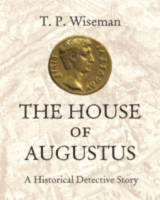
Princeton (2019) h/b/ 264pp £27 (ISBN 9780691180076)
W. is an original thinker and researcher with an enquiring intellect and a fine ability to identify and amass evidence from multiple sources. The central argument of his latest book is that the conventional view of the location and orientation of the Temple of Apollo, which Augustus dedicated in 28 BC, is incorrect. Delving back to Romulus and the first settlements on the Palatine Hill and critically assessing the excavations of recent times, W. draws on a wide range of literary and archaeological sources to present an alternative picture of the Temple and its portico. The maps are not as clearly printed as one would wish, which makes it difficult even for an informed reader to draw definitive conclusions, but, in summary, W. supports the archaeologist Amanda Claridge, assistant director of the British School at Rome from 1980 to 1994 (where W. was later Chairman of Council) and challenges the techniques and conclusions of the established ‘expert’ Andrea Carandini.
Augustus built the Temple to Apollo as a thanksgiving for his victories over Pompeius Sextus and Cleopatra in 36 BC and 31 BC respectively. Within the Temple, as W. notes, a statue of Apollo was flanked by Latona and Diana, while outside there was a statue of Apollo Citharoedus and a portico with a Latin and Greek library and enough built space to house meetings of the Senate. W. rightly dismisses the orthodoxy that Horace was purely a literary poet, when the evidence points to his composing both choral and monodic odes for performance in the piazza. According to Flavius Josephus, the space could hold 8,000 people, and W. notes that the complex was in full sight of both Augustus’s house and the Temple of Juppiter Victor. The significance for Augustus’s prestige can hardly be overstated.
The quality and depth of W.’s research lead to riches beyond his central theme. He correctly describes Augustus as imperator (Commander) and princeps (First Citizen), rather than ‘Emperor’, and takes issue with the perception that he rose to power by destroying the Republic. Rather he sees him as a populist, championing the plebs against the senatorial oligarchy of optimates and maintaining his authority through constitutional means. This is a useful antidote to the critiques of Tacitus and Lucan and a recent accusation by Syme that Augustus ran an ‘authoritarian regime’ and a ‘totalitarian state’.
In a footnote, W. acknowledges the ‘more nuanced judgement’ of Andrew Wallace-Hadrill. After the failed ‘coup d’état’ of Fannius Caepio in about 23 BC, there was a second accommodation with the senate, the first having taken place four years earlier. Thereafter, Augustus’s formal authority seems to have rested on his proconsular imperium, tribunicia potestas, control of the censorship and leadership of the quindecimviri sacris faciundis. Augustus exercised firm control over the levers of civil and military power, and the regime rewrote or suppressed certain elements of history, but his popularity as the architect of a new age of peace and prosperity seems not to have been in doubt during his later years. W. touches on these issues, without fully exploring them, as that would have been outside the scope of his ‘detective story’. He is certainly justified in defending Augustus’s record in broad terms and seeking to restore greater objectivity to the debate.
The House of Augustus is a book of outstanding scholarship and independent but well-judged opinions, in which every chapter offers fresh information and insights. It is highly recommended.
Stuart Lyons
